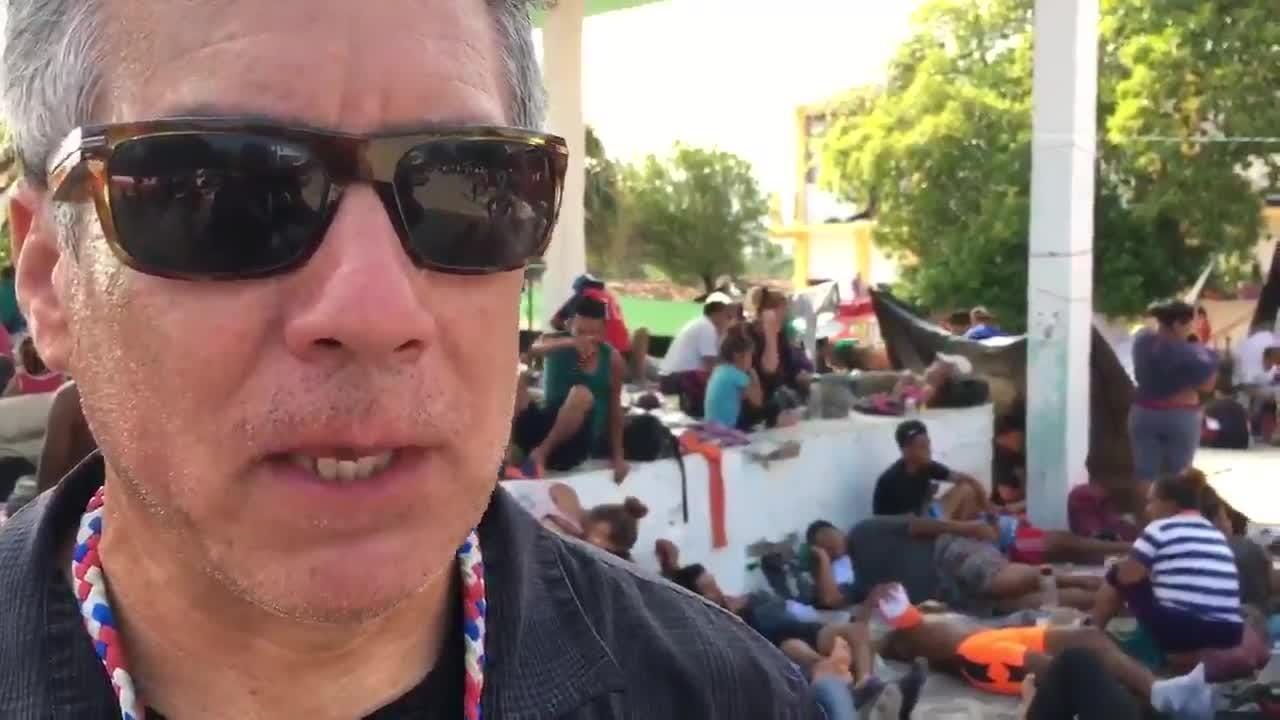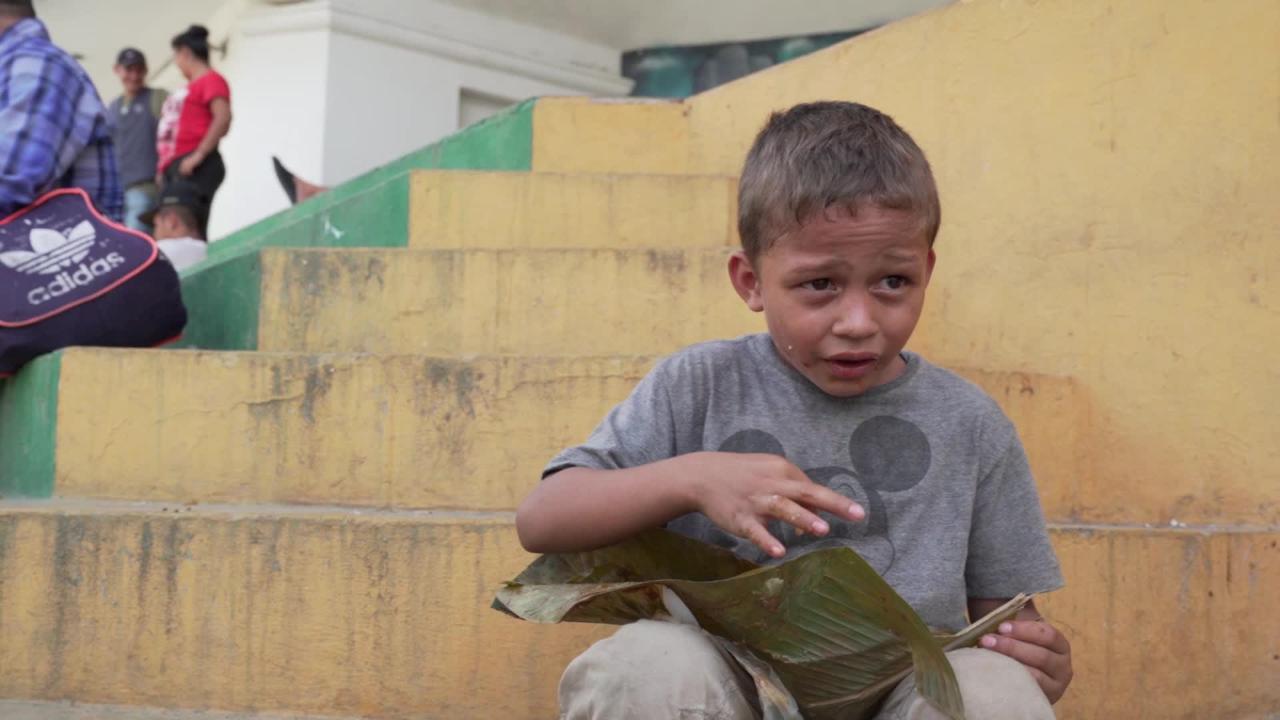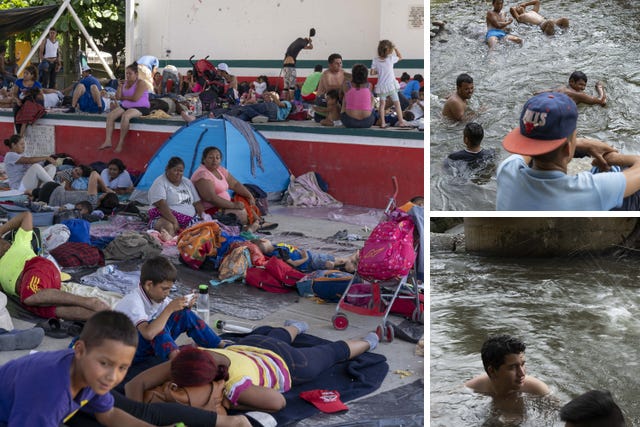DANIEL GONZÁLEZ | ARIZONA REPUBLIC | 4 hours ago

The migrant caravan has crossed the border from Chiapas into Oaxaca Mexico and is gathering for the night in the town of Tapanatepec.
NICK OZA, THE REPUBLIC | AZCENTRAL.COM
SAN PEDRO TAPANATEPEC, Mexico – Social media has filled with speculation that political organizations trying to influence the midterm elections are financing the caravan of Central American migrants walking to the United States.
Volunteers with the bi-national group Pueblo Sin Fronteras, which has stepped in to help coordinate the caravan after migrants crossed into Mexico from Guatemala, insist no political agenda or hidden hand is guiding the caravan.

Gina Garibo, one of the coordinators of the migrant caravan with Pueblo Sin Fronteras works on details for the Oct. 29, 2018 leg of the journey. The thousands of migrants from Honduras and other Central American countries traveling in a huge caravan toward the United States took a day off Oct. 28, 2018, to rest.
NICK OZA, FOR USA TODAY
Local residents, church groups and municipal officials in the towns where the caravan stops are feeding the migrants, many of whom are families traveling with children and babies and fleeing poverty and violence in Central America, coordinators say.
That appears to be the case.
► Oct. 29: Watch migrant caravan stream through immigration checkpoints in Mexico
► Oct. 29: Pentagon to deploy 5,200 active duty troops to U.S.-Mexico border
► Oct. 29: Central American migrant caravan: What we know
On Sunday, the caravan paused to rest after a week of walking in oppressive heat through the state of Chiapas and reaching the town of San Pedro Tapanatepec in Oaxaca state.
Throughout the day migrants lined up for plates of tortillas, beans and meat stew that parishioners of the town’s main church, Parroquia San Pedro Apostol, dished out. Women who identified themselves as volunteers from the office of the local municipal president distributed bottles of water from the back of a pickup truck as it inched through the streets, drawing crowds of parched migrants.
► Oct. 29: Far from border, immigration debate dominates many 2018 House races
► Oct. 27: Migrant caravan passes on Mexico's offer of work permits
► Oct. 26: Migrants gather on Guatemala border as another exodus takes shape
Later in the day, a long line quickly formed when another pickup truck pulled up in front of the stairs leading to San Pedro Apostol, and women handed out homemade empanandas, fried meat pies.
“We are doing this out of love,” said Imelda Sosa, 55, as she reached into a metal bin filled to the rim with empanadas.
Sosa said the volunteers handing out empanadas had come from El Templo Emanuel, an evangelical Christian church in the neighboring town of Chahuites.
NICK OZA, FOR USA TODAY
Local residents, church groups and municipal officials in the towns where the caravan stops are feeding the migrants, many of whom are families traveling with children and babies and fleeing poverty and violence in Central America, coordinators say.
That appears to be the case.
► Oct. 29: Watch migrant caravan stream through immigration checkpoints in Mexico
► Oct. 29: Pentagon to deploy 5,200 active duty troops to U.S.-Mexico border
► Oct. 29: Central American migrant caravan: What we know
On Sunday, the caravan paused to rest after a week of walking in oppressive heat through the state of Chiapas and reaching the town of San Pedro Tapanatepec in Oaxaca state.
Throughout the day migrants lined up for plates of tortillas, beans and meat stew that parishioners of the town’s main church, Parroquia San Pedro Apostol, dished out. Women who identified themselves as volunteers from the office of the local municipal president distributed bottles of water from the back of a pickup truck as it inched through the streets, drawing crowds of parched migrants.
► Oct. 29: Far from border, immigration debate dominates many 2018 House races
► Oct. 27: Migrant caravan passes on Mexico's offer of work permits
► Oct. 26: Migrants gather on Guatemala border as another exodus takes shape
Later in the day, a long line quickly formed when another pickup truck pulled up in front of the stairs leading to San Pedro Apostol, and women handed out homemade empanandas, fried meat pies.
“We are doing this out of love,” said Imelda Sosa, 55, as she reached into a metal bin filled to the rim with empanadas.
Sosa said the volunteers handing out empanadas had come from El Templo Emanuel, an evangelical Christian church in the neighboring town of Chahuites.
'There is nothing political here'
Coordinators with Pueblo Sin Fronteras say the caravan operates with no hierarchy but rather by consensus.
Each evening, after the sun goes down and the oppressive heat dissipates, migrants are invited to the center of town to listen to plans from volunteer coordinators.
“They are given a chance to agree or disagree. No decision is made without the input of our collaborators,” Nelly Espinoza, a volunteer with Pueblo Sin Fronteras, said of the migrants traveling with the caravan.
► Oct. 26: Mexico says it will offer work permits, health benefits to migrants who stay
► Oct. 26: Trump considering 'every option' to stop caravan from reaching border
► Oct. 26: What is asylum, and can Trump shut down the migrant caravan?
Pueblo Sin Fronteras is responsible for organizing previous caravans, including one this past spring that prompted President Donald Trump to order the deployment of National Guard troops to the southern border. That caravan inspired the massive caravan now crawling toward the U.S. border, which has inspired yet more caravans in its wake because of the dangers of traveling as a single family of migrants through Mexico.
Trump has promised to prevent the caravan from entering the U.S. and warned Mexico and other Central American countries that they will lose U.S. aid if they don’t do more to stop the mass of people fleeing those countries and passing through Mexico on the way to the U.S.
Even so, on Sunday, another group of Central American migrants numbering about 800 crashed through a gate on the Guatemala side of an international bridge and were insisting that they be allowed to pass into Mexico, the Spanish-language television network Univision reported. Reports differ on whether a Honduran in that group died because of Mexican police actions or in the chaos at the time.
Coordinators with the first caravan decided to rest Sunday after migrants from El Salvador attacked and beat a Guatemalan migrant, mistaking the man for a kidnapper. The beating followed rumors that two hooded men with rifles had tried to kidnap children from the caravan, according to some migrants.
A Mexican media channel captured the fight on live television, said Alfredo Castro, a journalist with Meganoticias in Oaxaca.
► Oct. 26: Migrant caravan: Why they left their homes, how many are traveling
► Oct. 25: Migrants traveling in caravan grow to 10,000, support group says
► Oct. 25: Trump officials may seal the border, deny asylum applications
The Guatemalan migrant was not seriously injured, and police arrested the Salvadoran migrants, coordinators with Pueblo Sin Fronteras said.
The conflict was a sign of rising tensions as migrants grow more exhausted and the disorganization of the caravan becomes increasingly apparent.
At a news conference Sunday, coordinators announced they had decided to call a rest day.
► Oct. 25: President Trump latches onto migrant caravan as top issue in midterms
► Oct. 25: Fact check: Trump's stump speeches on immigration
Coordinators also announced a “security committee” of about 100 “trusted” caravan members had formed to help maintain order, especially when volunteers are serving food. Chaos has accompanied food distribution, as migrants rushed to grab plates before food runs out, which invariably happens.
Some also have become frustrated with the caravan’s slow pace and the decision to continue on foot, instead of hopping freight trains, as previously caravans have done.
► Oct. 25: Trump to send at least 800 troops to border ahead of migrant caravan
► Oct. 24: Tracking the caravan: Traveling town to town in journey to U.S. border
Still, some migrants said they have confidence in the caravan’s coordinators and are sure they are not pawns to some hidden political agenda.
“There is nothing political here,” said Carlos Alberto Maldonado, a 32-year-old migrant from San Pedro Sula where the caravan began in Honduras. “They are just trying to help the migrants because they have seen what is happening in our country.”
Migrants playing a card game near a cement stage in the town plaza nodded in agreement.
'A lot of gangs and extortion'
Maldonado said he and his wife, 21-year-old Denisa, learned a caravan was forming from television news in Honduras. Maldonado said he and his wife decided to join two days later because they had grown fatigued with the violence and lack of employment in Honduras.
In Honduras, Maldonado said he earned about 300 lempiras a day, or about $12.50, painting houses and installing sheet rock.
► Oct. 24: GAO: Agencies unprepared for Trump’s migrant family separation policy
► Oct. 23: Trump makes dubious claims about Central American migrants
In the United States, he heard that he could earn twice that amount in an hour doing the same work.
What's more, in Honduras, "There are a lot of gangs and extortion. The gangs make you pay a portion of your salary, and if you don't they kill you and they kill your family."
He heard that about 500 migrants would be traveling together. But as the caravan moved through Honduras after leaving San Pedro Sula in mid-October, thousands had joined, he said
► Oct. 23: Who is behind migrant caravan? Ignore conspiracy theories, activists say
► Oct. 23: Previous caravan faced same scrutiny. Here is how that turned out
“It just kept growing and growing and growing,” he said.
When asked if he knew who organized the caravan before it left Honduras, Maldonado shrugged.
“Really, I have no idea,” he said.
Migrant caravan from Central America
'What little we have we want to share'
Coordinators with Pueblo Sin Fronteras said they inform local officials a day or two before the caravan arrives in a town, giving the officials and residents time to prepare for the arrival of thousands.
With limited public bathrooms available, migrants are forced to relieve themselves anywhere they can. By Sunday afternoon, the streets lining the town’s center here reeked of urine and feces.
Even so, local residents seemed to welcome the migrants with open arms, with some opening their doors to let them use toilets and allowing them to sleep on patios.
► Oct. 23: Migrant caravan is major concern for attendees of Trump-Cruz rally
► Oct. 22: Trump vows to send as many troops as necessary to stop caravan
Carmela Enriquez, 34, whose family operates a small chicken barbecue restaurant a few blocks from the city center, watched Sunday as migrants from the caravan wandered by, looking for a shady spot to rest.
She had read on social media that the caravan was to arrive two days before it did, she said. Even so, the size of the caravan caught the town off guard.
“I have to say, we were surprised by all the people,” she said.
► Oct. 22: Caravan migrants flood southern Mexico, tugging suitcases and hopes
► Oct. 21: Migrant caravan bound for US swells despite Trump threats
Enriquez said most people were not upset that thousands of migrants had completely taken over the center of town. She knew many who spent days making bread and other food to pass out to the migrants even though most residents of the town have little themselves.
The migrants are from other countries, “but we don’t discriminate. What little we have we want to share,” she said."These are not people with the intention to do harm. They are trying to better their lives."
Follow Daniel González on Twitter: @azdangonzalez

Migrants from Honduras and El Salvador gathered on Oct. 25, 2018, near a park in Tecun Uman, Guatemala, waiting to cross from Guatemala to Mexico.
NICK OZA, AZCENTRAL.COM
Originally Published 13 hours ago
Updated 4 hours ago

No comments:
Post a Comment